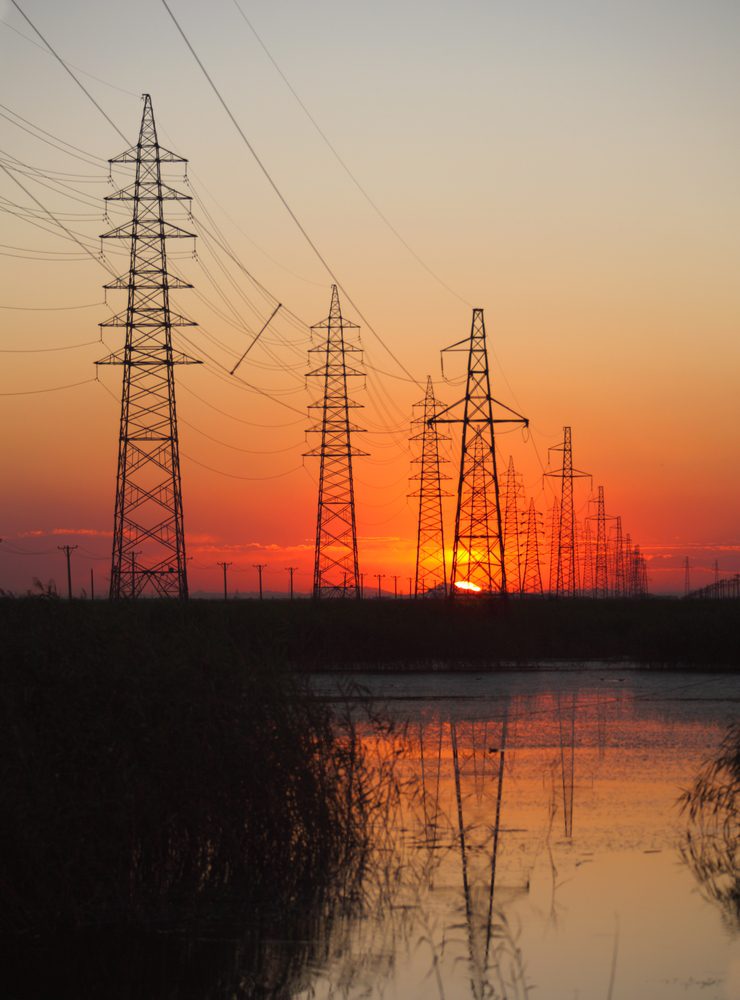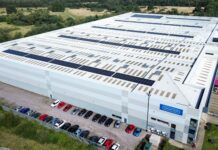
Is it time to get excited about solar? A panel debate in May provided a picture of the challenges and opportunities facing the sector in Scotland. Paul Marsh reports
NOW the fastest growing renewable energy technology in the world, solar photovoltaic (PV) is closing in on cost parity with fossil fuels, and many believe it could be set for a dominant role in the energy mix. But as a commercial technology it has fallen short of expectations in the UK. A chaotic subsidy situation hasn’t helped. Other obstacles in the immediate future include a lack of grid capacity, and the technology’s poor public perception.
Networking group eCoConnect’s panel discussion was titled “Scottish Solar: Blue Skies Ahead?” and judging by the 60-strong audience which attended – including many recognisable company names from the UK solar PV industry (there was only one solar thermal manufacturer) – there is a strong appetite for answers to the questions with which the sector is grappling. Framed by the looming presence of Edinburgh Castle – visible in the background – the four panellists offered opinions on the lessons to be drawn from the sector’s history, and the issues that need to be tackled if it is to have a strong future in Scotland. The speakers believed the recent UK election results gave cause for both hope and caution.
The panel
Drawn equally from the worlds of academia and the solar industry, the panel comprised John Lindsay, a development manager with Lightsource Renewable Energy, one of the UK’s largest solar developers, working mainly in ground-mounted PV arrays; Neil Roberts from the University of Edinburgh, who has been researching solar energy for 12 years; Neil Sutherland, regional director with Wardell Armstrong, an environmental, engineering and mining consultancy with a lot of experience in the sector; and John Forster, who owns a number of construction firms in Scotland, including a solar PV installer and a large roofing business. He is also on the board of the new Scottish branch of the Solar Trade Association.
The words “Scotland” and “solar” haven’t seemed like natural companions. Solar PV owes its rapidly improving affordability and performance to a healthy take-up in more tropical climes. Naturally enough, the pattern of UK deployment has so far favoured the south, especially the south-west of England, with a gradual progression northwards taking hold more recently. Over that period the sector has been subject to periods of quite extreme boom and bust.
The evening’s moderator, Craig Whelton of Burness Paul LLP – who was described as “a specialist in all aspects of consenting renewable energy projects” – asked the panel: What can we do in Scotland to ensure we avoid the pitfalls of what has happened south of the border? What can we take from that experience?
Lindsay flagged up stable government policy as a missing piece of the puzzle to date, referring to the “solar-coaster” of subsidy provision and the impossibility of having confidence that promised support will endure for any predictable length of time. The new STA Scotland trade body will help here, he said, through sensible lobbying. Another obstacle for developers like him is the lack of transmission capacity, and the need to update the grid.
But he offered his belief that the sector could well emerge in four or five years’ time, subsidy free but in a healthy state, the costs of construction having come down. There’ll be lots of capacity in the grid and “we’ll all be very rich solar developers”.
Offering a view from academia, Sutherland followed a similar tack: The subsidy side of things should sort itself out in the next three years. There has been boom and bust in the UK sector but it’s a similar story in every other country developing a PV strategy, and it’s do with the difficulties of setting the appropriate subsidy level. “It’s either not enough or suddenly it’s enough, and the moment it’s enough everyone wants to do it all at once, you have a boom, and then the government panics and it’s a bust.”
But he agreed that “the barrier to truly colossal uptake of solar PV in Scotland as well as the rest of the world is not PV technology but storage and management”. The grid, he said, is “most definitely a cause for gloom on the horizon if we don’t do something about it”
Solar thermal: A neglected technology?
While all the big news has been in PV, solar thermal developers have been sidelined as it’s never had the subsidy in place to grow the market and bring prices down. Particularly in Scotland, there needs to be some serious thought about that, he said. The incentives for renewable heat have not done for solar thermal in Scotland what the feed-in tariffs have done for PV. And Scotland has a particular demand, distinct from other parts of the UK. There are huge problems with fuel poverty and at least three times as much energy goes towards heat as electricity. “If we seriously want to do something transformative as a society in Scotland then this heating aspect needs to be considered,” he said.
Roberts of Wardell Armstrong felt that “politics can be overestimated”, although he looked forward to “a fascinating discussion between the Conservatives and SNP over what exactly does or doesn’t get devolved”, while being unsure of where energy sits in that tug of war. But it could be a game-changer as “the Conservatives have always been very anti solar PV ground-mounted”, and this industry has sparked into life more or less despite their intentions. The progressive cutting of tariffs has made life much more difficult for developers like Lightsource.
If aspects of energy do get devolved then “personally I think that gives the SNP an opportunity but whether they take it is a different matter.” But a more favourable slant on policy and tariffs could result in “a clear, concise and transparent energy policy so everyone knows where they stand”.
It’s always been the intention for the tariffs to regress till we reach parity, but the timing of reductions is key, he said. If government can avoid the temptation to meddle, to keep changing tariffs on a knee-jerk basis, then “it allows manufacturers to understand where the business is going so they can price accordingly, it allows investors to understand, it allows everyone else to understand the pressures and the peaks and troughs in demand – that in itself will even out to a degree at least the boom and bust.”

For firms in the sector it might be worth thinking a bit differently about incentives, he said. “I strongly suspect that – going forward – a number of the solar firms – or a lot of the guys doing the roof-mounted side of things – will become ESCOs [ (Energy Savings Companies) ] as that’s a good way of avoiding the tariff conundrum.” If you offer your services directly to users, in other words, then you don’t actually need the tariff. “It makes a whole lot of sense,” he said. Financial modelling becomes a lot more predictable, and things become potentially more profitable “but there’s a lot more effort involved”, he said, a trade-off as always.
You can be inventive too, he said, pointing to opportunities to use existing grid capacity by, for example, bolting on solar arrays to an existing wind farm, something he has been looking at over the past three years.
Overcoming the past
But it’s also very important to “do things well”. Reflecting on the experience in the south of England, it was clear that some of the sites chosen weren’t the best. This was at a time when it was relatively easy to develop sites for solar, as it now is in Scotland. As a result, “we’re living with a legacy of ‘that’s what it’s always going to look like’”.
Another strand he highlighted was “the need to bring the public with us╔ not to impose but to make sure the public understand what solar PV is, understand what the impacts are, and what the benefits are, so we can have an informed discussion and avoid a lot of the conflict that is emerging in England”.
“Westminster has done a marvellous job of making a complete and utter mess of it,” said John Forster – “not a political judgement, just a reality”. At one point there were over 8000 installers registered in this country to carry out the retro-fitting of domestic properties at 4kW or less, now there are 1500 – a drop that would have to be considered “a catastrophe”. He said: “I think you’d struggle to find an industry that anyone has managed to create in about 18 months and then destroy in about 6 weeks.”
Germany is “several years ahead of us”, he said. “The bizarre thing is: We’ve gone through a learning experience in the UK that we didn’t need to – someone else has already done it.” Sometimes it’s better not to stare at our navel, but to look a bit further afield. Scotland is especially behind, with the latest figures expected to show gigawatts of installed capacity in the UK, compared to the couple of hundred megawatts the industry has in Scotland. “We’re at best a quarter of what we might have had or should have had,” he said.
We need to prepare to take advantage of the opportunities out there. The new Scotland STA will help. The trade association – of which he is a board member – is now pushing out a plan for solar to be independent of subsidy by 2020, an issue of central importance if solar is to deliver on its potential. “The industry has a tendency to look over its shoulder at what’s just been, and usually the disruption that’s gone with it, instead of thinking ahead.”
One development that should especially excite solar developers is the new Tesla home battery. Battery technology is essential to making PV work at a domestic level, and it is being developed primarily for electric vehicles.

So there are big changes afoot with the power systems being used in places like the home. If we had a simplified market to work in, we might be better positioned to take advantage of such opportunities. To that end Forster said he had met recently with Fergus Ewing and other members of the Scottish Government, and was greatly encouraged by their positivity and the sense that “there is a vision for solar”.
On the ambition to be subsidy-free by 2020, Whelton asked what are the most pressing priorities to address to allow us to reach that point?
Since the panels are manufactured mostly in China, the fundamental cost of the technology is a factor over which we have little control, suggested Forster. But it seems clear that panels will continue to get cheaper and more efficient. While today’s installers might typically be fitting a 16% efficiency panel, there are panels in the US offering 45%, though they might be a long way from commercialisation. “We can be confident that the cost of generating is just going to go down”, he said. Against that, all the predictions tell us that the energy solar hopes to displace is just going to get more expensive.
Opportunities in Scotland?
An audience question asked the panel if they saw a future for solar thermal in the UK, particularly in Scotland.
Sutherland said that solar thermal was commercially successful in the US 100 years ago but was relegated to the back seat by cheap fossil fuel, and has never recovered its competitiveness. Government support is needed if it is not to be “washed away by PV”. We can’t rely on the worldwide mass market the way we can with PV. It’s a “latitude” issue, he suggested. Specifically: Our latitude. It’s not going to be driven by massive usage in warmer climates like PV. Scotland needs to take some leadership on solar thermal.
Another audience member, a representative from Greenhedge Renewables, a UK solar developer, asked about grid constraints in Scotland. His firm gets 9/10 applications back with ‘not before 2023’ and that kind of thing, he said. What are we going to do about the grid?
Lindsay suggested there are big infrastructure projects in the pipeline such as in the southwest of Scotland – the 2023 date hadn’t been plucked out the air, in other words – and these promise to make extra capacity available. “Six months ago it would have been empty optimism but there’s definitely projects to be built, I think.”
Putting in the groundwork
Any prospective solar industry relies upon a healthy ground-mount sector being in place, he said – a message that needs to make it to the Scottish government. “If we do it tastefully and in areas that are not too visible then it’s a vital part of the energy mix for Scotland. Solar’s day has come subject to overcoming grid restriction, becoming subsidy free and construction costs becoming sufficiently low to make it viable.
Sutherland said another way of overcoming the grid problem is to develop brownfield sites or sites adjacent to energy users, and sell directly to them.
Forster lamented the grid constraint and its effect even on small-scale installations. “If you’re a manufacturer with a plant with a reasonably sized roof, and you want to put a 100kW system on it to make a significant impact on your energy purchasing, then you can’t do it because you can’t get a connection until 2025.” Telling people that ‘yes you can have your 100kW connection if you’re prepared to pay £1.2M for a grid connection’ is “not very helpful”, he said.
Another questioner wondered what developers are going to do in the short term, given the grid situation and the (downward) trajectory of subsidies?
Lindsay said there were two aspects to the question, given the two levels of subsidy being pursued with solar: ROC in the case of sub-5MW projects and CFD for anything above that. His own focus in Scotland is more on ROC projects and it seems another two years of that subsidy can still be counted upon. Hopefully the costs will have come down by that point. And on the grid side, he planned to continue with a strategy of locating pockets of grid availability wherever he could – “fingers crossed, touch wood, in five years’ time i’ll still have a job.”
There was some discussion of the need for more progressive DNOs, referring to the Distribution Network Operator firms who own and operate the grid. Speaking of the stakeholder meetings he’d attended, Lindsay said he had the sense that there was some real interest in supporting renewables within SP Energy Networks, for example, which bodes well.
The DNO issue is complex, said Forster, and “we seem to have relatively modest influence over it, including as a trade body. Government has relatively little influence there, but they have some, and we need to ensure it is sending the right message to the DNOs, through better consistency of language and consistency of requests on the solar industry’s part. He added that: “There is no shortage of global capital to invest in infrastructure – so money isn’t the issue.”
Iain Telford of North Lanarkshire Council asked about the landfill ban in 2020. It seemed to make available suitable sites for ground-mount solar, and ones already equipped with a grid connection. What are the prospects here?
Sutherland said this was indeed possible, and he was working on a project of this kind currently, details to be announced soon.
Another question asked about the likely shape of energy storage in Scotland. Roberts said the Tesla wall-mounted device will store about 10kW and the cost is not prohibitive. “The solar panels on my roof give me an average of 10kWhours per day over the year, and that’s great as that’s close to what a family uses.” But that translates into 15kWhours per day during the summer and five a day over the winter, and current battery technology is not addressing that seasonal storage, a more critical issue in Scotland than England.

Forster referred to the “average family home” model of Roberts’ answer in explaining a scenario where he believed the same home could cut the amount of electricity it purchases by around 60%. He apologised for the unashamed “crystal ball” gazing while he explained: The Toyota Mirai fuel cell car is being launched in 2016. “The most interesting thing about that vehicle is you can plug it into your house and run your house off it,” he said. So you can imagine a scenario where a new build house has solar panels on the roof, both thermal and PV – with more significant electrical storage capacity associated with the PV. The house doesn’t have a boiler as there is enough power generated during the day, and stored in a battery, to run the house 24/7. And if you do run a bit short in winter, when you come home at night in your hydrogen fuel cell far you can plug it into the house and run the house off it – the roles being reversed in the summer months, meaning you don’t need so much hydrogen fuel. “All that technology is there now,” he said, suggesting that whenever we’re getting bogged down in the challenges of the grid and so on, we should remember that “there are some truly remarkable solutions out there.”
The pace at which things are moving should give pause. It was only in recent months he was at a meeting where “we were talking about how it might be three years before we’d have a serious domestic storage unit, and one was launched last week! [ referring to the Tesla unit ]”.
FIT for purpose?
Increasing levels of solar are coming online for social housing, and with government and local authority buildings, all of which is at the sub-150kW level. But the funding model for all of this “is predicated on the generosity of the feed-In tariff” as one questioner put it. With the ongoing degression In all bands of the FIT, it looks unlikely that this funding model can endure.
Forster believed the situation was “very sensitive”. The industry desperately needs to get subsidy free.
For example the FIT review scheduled for autumn of this year will be driven by the European aspect and limits defined within the EU. The commercial rooftop space is seeing ROI levels of 20%+, which goes way beyond the 6% to 8% permitted within European rules. “Whatever DECC or the new Westminster government say they’re going to do, if at the end of the day it’s outside the parameters then it will be cut and savagely cut, and we’ll have hyper-degression and a market like commercial rooftop which is just emerging will suffer badly.” It’s a very difficult landscape to operate in, the unpredictability of it. “Talk about business planning a year ahead – goodness me, sometimes you don’t know where you’re going to be in six months.”
Brenda Park of Amec Foster Wheeler asked about Scotland-specific challenges. Sutherland said that, unlike England where solar now has “a very mature market”, Scotland has next to nothing. Local councils have started to show an interest – and there are certainly two active at the moment – but there are challenges with communicating the benefits of solar to this sector, and the high level of staff churn doesn’t help. There is a big learning curve with solar, and “you need to put in at a lot of effort at the start, to ensure you get a smooth and quick decision”.
Speaking for STA Scotland, Forster praised the helpfulness and supportiveness of the Scottish government, with whom he’d been present for discussions on things like development rights and the move to 1MW on rooftop. Another issue on which the STA is seeking clarity is rateable value. Looking at the example of 100kW solar, in England the rates paid might add a few hundred pounds onto the cost of an initial application while in Scotland this could be in excess of £6k, so “there are some grassroots activities we need to get”, he said.
Decentralising power
The topic of “smart grids” was raised, where intelligence in the grid regulates the power flowing in and out, to best match supply and demand. Work has been done in this area with things like electric vehicle charging stations, asking them to reduce their consumption at times of high demand. Forster believed it was difficult to comment on a technology that still seems a few years away from deployment, and it might even be pointless to do so. “We’re in an industry that changes every single week,” he said, and seemed to think smart grids were academic in the absence of basic grid capacity. There may be lots of more immediately practical technologies waiting in the wings. He drew an analogy with the work that was being done to explore hydrogen fuel cells as boiler replacements about eight years ago. On asking a champion of the approach how he would tackle the obstacle of hydrogen distribution, he was told: ‘Oh it’s easy – we’ll just change the whole natural gas grid to hydrogen’. “Let’s do the manageable tasks first”, he said, to the sound of an amused audience, before Sutherland interjected that he was actually working with DECC at the moment, exploring the feasibility of changing the gas grid to hydrogen in Cowdenbeath.

Smart grid might not be fully on the cards yet, said the questioner, but maybe we’re in an intermediate stage, where power distribution and storage is becoming more and more decentralised. How viable is it to be investing in the grid in its current state to keep up with the influx of things like solar when we could be ten years or whatever away from seasonal storage, which could really decentralise it, even if it doesn’t transform it into a smart grid? Lindsay mentioned that the grid infrastructure is currently 70 or 80 years old, so it certainly needs an upgrade, but conceded It was really a question for the CEO of SSE. Forster said planning ten years ahead was still the best we could do, even If we do eventually “chuck the plan in the bin to an extent”. He believed we might realistically look to improve the inter-connective capacity of our electricity networks so we can export more. Maybe we shouldn’t just be aiming for the target of 100% renewable by 2020 – which we’re half-way towards achieving – but look to the possibility of Scotland’s renewables becoming an export industry.
Someone else asked about STA lobbying efforts to remove the cap on new solar projects, something Forster – who has only joined the STA board this year – said hadn’t been part of his discussion with Fergus Ewing, but agreed it was a key barrier to working towards a zero-subsidy scenario. The STA is working with European legislative bodies on this issue, he said.
One wish each
Catherine Hokin of eCoConnect sought to round up the event to a close by asking each of the panel to name the one thing they were really wishing for, that could help the sector take off in Scotland. Lindsay said that, clearly, if there were pots of money Scotland could put aside for the solar sector to give us a better subsidy to put us on a par with our European counterparts, then that would stop us having to “cut our cloth” so quickly.
Roberts said what he wanted for Xmas was an R&D strategy. “In a vastly expanding market there’s going be a lot of space for niche products: bespoke products for certain latitudes, building styles, technologies, and products for things like portable, wearable and indoor usage.” At the moment development is very piecemeal, via a loose network of spin-out companies and academic researchers – they talk to each other but aren’t always able to work together because the Scottish Institute for Solar Energy Research (SISER) is a network rather than an authoritative body. “If we spot, for example, a gap in the academic capability of Scotland we can’t easily plug it.” SISER needs a central focal point, which might be a funding mechanism or a physical location.
A clear policy for planners
Whelton – who made the biggest confession of the night by saying “I love policy” – wished for a greater level of policy support in the planning sector – at both government and local level. “I’d like to avoid getting into a trial and error situation – which is what you see now to a degree with onshore wind, where some schemes go through but some don’t and no one is entirely sure why.” The scale of development with things like onshore wind has led to real challenges for renewable projects, in consenting terms. “It would be nice if we could pre-empt that and get a clear policy in place, before people have to learn through the appeal process, which is expensive.”
Sutherland said his magic wish would be a way of strengthening or speeding up the grid network within the UK. “No matter what technology is being developed, it all needs to plug in somewhere and unfortunately the network we have is prehistoric and not fit for purpose – these investments take time and there isn’t a way to do quickly but if there were that would be my wish.”
Forster said for all the talk of Scotland trailing England, he believed there were developments underway “that will allow Scotland to demonstrate soon that it is leading in the application of solar”. One is the new Building Regulations, coming out in October. By late 2016 and 2017 we might well get to a point where as much as 75% of new build housing in Scotland uses solar PV. “That will be miles ahead of the chaos that exists under the Zero Carbon Homes scheme,” he said, referring to the 2006 government initiative which is believed to have fallen far short of expectations.
“The [ Scottish ] government has this target of 100% for renewable energy by 2020, which by itself is a fantastic commitment and you sense the passion of people to meet the target.”
So the new energy efficiency requirements for new build in Scotland seem a no-brainer. “Why would we have buildings that don’t have self-generation of electricity as part of their infrastructure? But yet we have been doing that and England will carry on doing that for some time.” The progress so far has been encouraging, he said. “But there are some bold decisions to be made.”
The election result didn’t bode well for these issues on a UK level, he suggested, with the Conservative government’s track record being “pretty horrendous”. But the election result in Scotland could be cause for optimism, given the strong result for “a party that believes very much in the opportunities of renewables to change our energy landscape”. He concluded with the hope that “the 56 voices” have some influence on the issue in Westminster.






